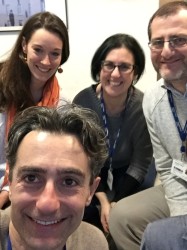Summary

AMPKalpha1 deletion promotes robust regrowth after a spinal cord injury
I hold a Chair in Restorative Neuroscience at Imperial College where my research group investigates the molecular signalling and transcriptional mechanisms that control axonal sprouting and regeneration. I also hold a honorary post within the NHS as a consultant in Neurology. Previously, since 2006, I worked at the University of Tuebingen, Germany as a Research Group Leader, where I was also a consultant clinician in Stroke and General Neurology.
I did my post-doctoral training in Neuroscience studying gene expression regulation after spinal cord injury at Georgetown University, Washington DC, 2001-2004 where I became research Instructor (2004-2006). I studied Medicine at La Sapienza University and did my Neurology training at Catholic University, Rome, Italy.
Research in my group aims to investigate the molecular signalling mechanisms that discriminate between axonal regeneration and regenerative failure including following peripheral and spinal cord injuries respectively. In fact, while a regenerative programme is induced following peripheral axonal injury, this fails after an axonal central nervous system injury. Therefore we prioritize the study of the post-injury differential regenerative ability of dorsal root ganglia neurons whose axons project both into the PNS and CNS. They are pseudounipolar sensory neurons that from the same cell body project a peripheral regeneration-competent axon to the periphery and a central regeneration-incompetent axon into the dorsal column of the spinal cord.
Since axonal regeneration in the peripheral nervous system is imperfect and inefficient, enhancing the regenerative properties of the injured central nervous system such as in the spinal cord may be important to promote recovery of function and limit neurological disability in both spinal cord and peripheral nerve injury. Our work can have broad implications for conditions spanning from traumatic, vascular, inflammatory, degenerative and metabolic (such as diabetes) damage to the spinal cord, spinal roots and peripheral nerves.
FOLLOW OUR LAB on twitter @Digiovannilab
LAB MEMBERS
Ilaria Palmisano, senior post-doctoral fellow
Francesco De Virgiliis, post-doctoral fellow
Luming Zhou, post-doctoral fellow
Guiping Kong, post-doctoral fellow
Elisabeth Serger, post-doctoral fellow
Franziska Mueller, PhD student
Jessica Chadwick, PhD student
Yuyang Yu, PhD candidate
ALUMNI
Thanks to the past lab members!
Arnau Hervera, Radhika Puttagunta, Giorgia Quadrato, Andrea Tedeschi, Ricco Lindner, Kirsi Forsberg, Marilia Soria, Yashi Joshi, Perrine Gaub, Tuan Nguyen, Elisa Floriddia, Kizhir Rathore, Elidh Maclachlan, Paolo La Montanara, Thomas Hutson
Restorative Neuroscience research
For further information the role of Prof. Di Giovanni within the Division of Neuroscience please skip to the 3 minute mark on the video below or use the following link:
https://www.youtube.com/watch?v=TQ4UPKcdnOU#t=184.
Additional information on the Division of Neuroscience within the of Imperial's Department of Brain Sciences can be found here: http://www1.imperial.ac.uk/departmentofmedicine/divisions/brainsciences/restorativeneuroscience/
Selected Publications
Journal Articles
De Virgiliis F, Di Giovanni S, 2021, Reply to: Neuroimmune interactions and COVID-19 in lung transplant recipients, Nature Reviews Neurology, Vol:17, ISSN:1759-4758, Pages:325-326
Kong G, Zhou L, Serger E, et al., 2020, AMPK controls the axonal regenerative ability of dorsal root ganglia sensory neurons after spinal cord injury., Nature Metabolism, Vol:2, ISSN:2522-5812, Pages:918-933
La Montanara P, Hervera A, Baltussen L, et al., 2020, Cyclin-dependent-like kinase 5 is required for pain signaling in human sensory neurons and mouse models, Science Translational Medicine, Vol:12, ISSN:1946-6234, Pages:1-11
Bradke F, Di Giovanni S, Fawcett J, 2020, Neuronal maturation: challenges and opportunities in a nascent field, Trends in Neurosciences, Vol:43, ISSN:0166-2236, Pages:360-362
Hutson TH, Di Giovanni S, 2019, The translational landscape in spinal cord injury: focus on neuroplasticity and regeneration, Nature Reviews Neurology, Vol:15, ISSN:1759-4758, Pages:732-745
Palmisano I, Danzi MC, Hutson TH, et al., 2019, Epigenomic signatures underpin the axonal regenerative ability of dorsal root ganglia sensory neurons, Nature Neuroscience, Vol:22, ISSN:1097-6256, Pages:1913-1924
Hervera A, Zhou L, Palmisano I, et al., 2019, PP4-dependent HDAC3 dephosphorylation discriminates between axonal regeneration and regenerative failure, EMBO Journal, Vol:38, ISSN:0261-4189
Hervera A, Santos CX, De Virgiliis F, et al., 2019, Paracrine mechanism of redox signalling for post-mitotic cell and tissue regeneration, Trends in Cell Biology, Vol:29, ISSN:0962-8924, Pages:514-530
Hutson TH, Kathe C, Palmisano I, et al., 2019, Cbp-dependent histone acetylation mediates axon regeneration induced by environmental enrichment in rodent spinal cord injury models, Science Translational Medicine, Vol:11, ISSN:1946-6234
Hervera A, De Virgiliis F, Palmisano I, et al., 2018, Reactive oxygen species regulate axonal regeneration through the release of exosomal NADPH oxidase 2 complexes into injured axons (vol 20, pg 307, 2018), Nature Cell Biology, Vol:20, ISSN:1465-7392, Pages:1098-1098


